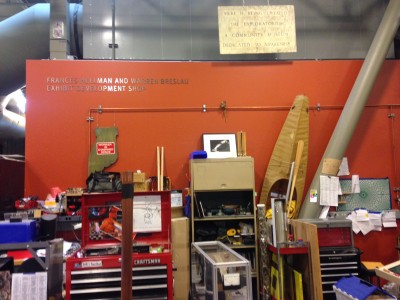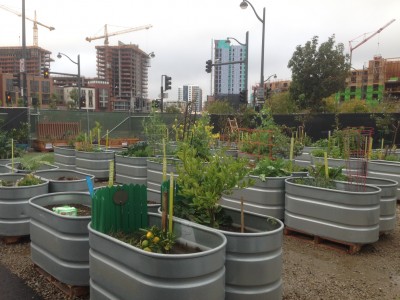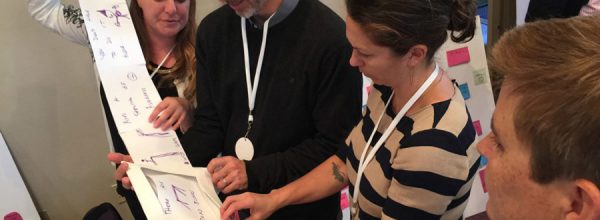CCI doesn’t believe in reinventing the wheel. Many of the challenges healthcare is tackling right now have analogues in problems faced by other industries.
From organizing workforce to harnessing inspiration, there is a lot we can learn—particularly about innovation—from forward-thinking organizations outside of healthcare. At the Fall 2014 meeting of the Safety Net Innovation Network, CCI lead safety net leaders on “innovation safaris” to organizations of all stripes, from restaurants to museums to non-profits to tech giants. Look below for summaries and photos from the SNIN safaris.
gravitytank
Gravitytank is an innovation consultancy that helps clients grow their businesses, define new products and services, enter new markets and change their organizations. They are pretty much ground zero for innovation work, bringing a multi-disciplinary team of researchers, designers and strategists to each client engagement. Most interestingly their workspace and styles reflect their approach. No one has a permanent workspace. There are no corner offices or other visible hierarchy. Instead “bays” are designated to a particular project. The walls of each bay are mobile, filled with post-it notes and design concepts, which can be easily transported to a larger client meeting space when needed. Often times the bay becomes transformed completely to reflect the project, such as in the case of the design of a new food item where the team recreated each stage of the use case from the ingredients of the product, to sitting on the grocery shelf, to home consumption.
SFMOMA
At the San Francisco Museum of Modern Art, safari-goers heard how the raising of a new building was being used to help the museum become more welcoming and participatory. This rebranding covers physical details of what happens when visitors walk into a space, but also touches on the role SFMOMA played in the community: free admission for those under 18, a new partnership with SF Unified School District, and a focus on designing spaces for all types of visitors. “Unless we connect with people and build relationships, it won’t matter how amazing the art work is,” Maria Jenson, Community Relations Public Partnership Manager, said.
One Medical
 The only health care-based safari site, One Medical is redesigning the patient experience to create a family practice that provides personalized care on the patient’s terms. They offer longer appointments that actually start on time, as well as the ability to book same- or next-day appointments or communicate with family doctors and staff through email, a mobile app or a 24/7 support line. Virtual visits using Google Hangouts are common, and they use a homegrown EHR system with templates customized by providers. Unlike many traditional clinics, One Medical’s waiting rooms are calm, with no ringing phones and a kiosk that makes it easy for patients to register. Staff space is pleasant and playful, and the staff themselves are young, without uniforms, hired based more on customer service skills. Providers see fewer patients each day, for appointments that can last as long as 45 minutes. Quality indicators are eschewed, while patient and provider satisfaction are gospel.
The only health care-based safari site, One Medical is redesigning the patient experience to create a family practice that provides personalized care on the patient’s terms. They offer longer appointments that actually start on time, as well as the ability to book same- or next-day appointments or communicate with family doctors and staff through email, a mobile app or a 24/7 support line. Virtual visits using Google Hangouts are common, and they use a homegrown EHR system with templates customized by providers. Unlike many traditional clinics, One Medical’s waiting rooms are calm, with no ringing phones and a kiosk that makes it easy for patients to register. Staff space is pleasant and playful, and the staff themselves are young, without uniforms, hired based more on customer service skills. Providers see fewer patients each day, for appointments that can last as long as 45 minutes. Quality indicators are eschewed, while patient and provider satisfaction are gospel.
T-Lab
 Acting as an R&D arm for poverty-fighting non-profit Tipping Point Community, T-Lab uses human-centered design thinking to innovate scalable solutions on childcare, pre-K and prisoner reentry. Teams of three “problem solver” fellows are brought in for six-month periods to study one of these problems and prototype interventions. Their process involves building deep empathy by interviewing subjects in their homes—“contextual inquiry”—to understand the conditions that make these problems so intractable. They also force practical protypes by prohibiting fellows from getting bogged down imagining policy changes, movement building and system redesign. From prisoner reentry kits in manila envelops to a traveling preschool in a remodeled school bus, cohorts of T-Lab problem solvers are building on each other’s work to design the next wave of Tipping Point solutions.
Acting as an R&D arm for poverty-fighting non-profit Tipping Point Community, T-Lab uses human-centered design thinking to innovate scalable solutions on childcare, pre-K and prisoner reentry. Teams of three “problem solver” fellows are brought in for six-month periods to study one of these problems and prototype interventions. Their process involves building deep empathy by interviewing subjects in their homes—“contextual inquiry”—to understand the conditions that make these problems so intractable. They also force practical protypes by prohibiting fellows from getting bogged down imagining policy changes, movement building and system redesign. From prisoner reentry kits in manila envelops to a traveling preschool in a remodeled school bus, cohorts of T-Lab problem solvers are building on each other’s work to design the next wave of Tipping Point solutions.
The Exploratorium
 A new water-front museum of science, art and human perception, the Exploratorium makes visitors active explorers of exhibits to encourage learning through play and immersive experiences. Exhibits are built to be open-ended, used in many different ways. This engages both children and adults and makes repeat visits more enjoyable. They develop these unique exhibits in an open workshop where visitors can tinker with unfinished exhibits to help designers understand how they learn. Project teams are multidisciplinary and work in a messy, open space filled with materials meant to jog inspiration. Everything is a work in progress and breakdowns are expected and accepted.
A new water-front museum of science, art and human perception, the Exploratorium makes visitors active explorers of exhibits to encourage learning through play and immersive experiences. Exhibits are built to be open-ended, used in many different ways. This engages both children and adults and makes repeat visits more enjoyable. They develop these unique exhibits in an open workshop where visitors can tinker with unfinished exhibits to help designers understand how they learn. Project teams are multidisciplinary and work in a messy, open space filled with materials meant to jog inspiration. Everything is a work in progress and breakdowns are expected and accepted.
Nomad Gardens
 Community organizers leveraging the power of soil and vegetables, Nomad Gardens creates pop-up community gardens that are mobile and can be moved at any time. Grown in small plots of dirt in metal tubs, these gardens provide a centerpiece for gardening workshops that can be brought into different communities to encourage the growth of green spaces and healthier eating. “Our focus isn’t urban gardening, but organic community engagement and fostering beautification within the community through revitalizing vacant lots,” said Anne Park. The discussions on the safari ranged from the philosophy of Nomad Gardens to brainstorming ways to bring gardens to hospitals as therapeutic spaces for chronic pain patients.
Community organizers leveraging the power of soil and vegetables, Nomad Gardens creates pop-up community gardens that are mobile and can be moved at any time. Grown in small plots of dirt in metal tubs, these gardens provide a centerpiece for gardening workshops that can be brought into different communities to encourage the growth of green spaces and healthier eating. “Our focus isn’t urban gardening, but organic community engagement and fostering beautification within the community through revitalizing vacant lots,” said Anne Park. The discussions on the safari ranged from the philosophy of Nomad Gardens to brainstorming ways to bring gardens to hospitals as therapeutic spaces for chronic pain patients.
Off The Grid
 Food trucks are becoming a staple of California foodie culture. Off The Grid organizes food trucks into community-building events, bringing many trucks together for afternoons or evenings of culinary diversity in school playgrounds and parking lots. These pop up markets “activate open space and create a community,” said Ben Himlan, Director of Business Development at Off The Grid. For the trucks, Off The Grid provides turnkey solutions, obtaining permits and keeping track of paperwork, as well as advertising their presence on social media. They focus on enriching the communities they bring their markets to, even through resistance. “We often, if not always, face opposition when going to a new location,” Himlan said. “We go door to door to talk to people and give proposals.”
Food trucks are becoming a staple of California foodie culture. Off The Grid organizes food trucks into community-building events, bringing many trucks together for afternoons or evenings of culinary diversity in school playgrounds and parking lots. These pop up markets “activate open space and create a community,” said Ben Himlan, Director of Business Development at Off The Grid. For the trucks, Off The Grid provides turnkey solutions, obtaining permits and keeping track of paperwork, as well as advertising their presence on social media. They focus on enriching the communities they bring their markets to, even through resistance. “We often, if not always, face opposition when going to a new location,” Himlan said. “We go door to door to talk to people and give proposals.”
Silicon Valley Bank
 Catering to startups and innovative technology companies, SVB councils that we should embrace the disruptors, even in relatively conservative industries like banking—or healthcare. The discussion on that safari focused on how the bank learns to cater to different types of customers by using interviews and research to develop “personas” around which they can design their user experience. They also shared a handy graphic describing a philosophy of building a product not piece-by-piece but ensuring that each iteration is minimally viable.
Catering to startups and innovative technology companies, SVB councils that we should embrace the disruptors, even in relatively conservative industries like banking—or healthcare. The discussion on that safari focused on how the bank learns to cater to different types of customers by using interviews and research to develop “personas” around which they can design their user experience. They also shared a handy graphic describing a philosophy of building a product not piece-by-piece but ensuring that each iteration is minimally viable.










